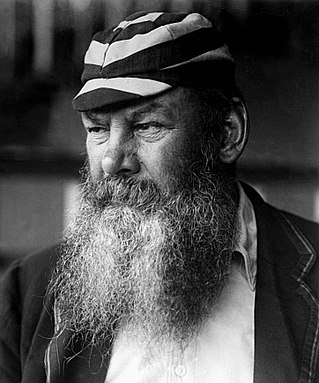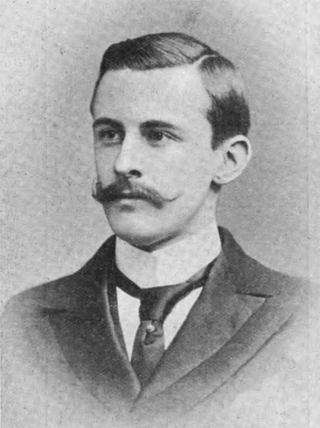
The Ashes is a Test cricket series played between England and Australia. The term originated in a satirical obituary published in a British newspaper, The Sporting Times, immediately after Australia's 1882 victory at The Oval, its first Test win on English soil. The obituary stated that English cricket had died, and "the body will be cremated and the ashes taken to Australia". The mythical ashes immediately became associated with the 1882–83 series played in Australia, before which the English captain Ivo Bligh had vowed to "regain those ashes". The English media therefore dubbed the tour the quest to regain the Ashes.

William Gilbert Grace was an English amateur cricketer who was important in the development of the sport and is widely considered one of its greatest players. He played first-class cricket for a record-equalling 44 seasons, from 1865 to 1908, during which he captained England, Gloucestershire, the Gentlemen, Marylebone Cricket Club (MCC), the United South of England Eleven (USEE), and several other teams.

Marylebone Cricket Club (MCC) is a cricket club founded in 1787 and based since 1814 at Lord's Cricket Ground, which it owns, in St John's Wood, London. The club was formerly the governing body of cricket retaining considerable global influence.

Lord's Cricket Ground, commonly known as Lord's, is a cricket venue in St John's Wood, London. Named after its founder, Thomas Lord, it is owned by Marylebone Cricket Club (MCC) and is the home of Middlesex County Cricket Club, the England and Wales Cricket Board (ECB), the European Cricket Council (ECC) and, until August 2005, the International Cricket Council (ICC). Lord's is widely referred to as the Home of Cricket and is home to the world's oldest sporting museum.

Albert Edwin Trott was a Test cricketer for both Australia and England. He was named as one of the Wisden Cricketers of the Year in 1899. He is believed to be the only batsman to have struck a ball over the top of the Lord's Pavilion. He is also one of only two players to take two hat-tricks in the same first-class innings, the other being Joginder Rao. Despite his notability, having played in 375 first-class matches including 5 Tests, he was almost penniless when he committed suicide at the age of 41.

Ivo Francis Walter Bligh, 8th Earl of Darnley, styled The Honourable Ivo Bligh until 1900, lord of the manor of Cobham, Kent, was a British nobleman, parliamentarian and cricketer.

Thomas Lord was an English professional cricketer who played first-class cricket from 1787 to 1802. He made a brief comeback, playing in one further match in 1815. Overall, Lord made 90 known appearances in first-class cricket. He was mostly associated with Middlesex and with Marylebone Cricket Club (MCC) as a ground staff bowler.

The St Lawrence Ground is a cricket ground in Canterbury, Kent. It is the home ground of Kent County Cricket Club and since 2013 has been known as The Spitfire Ground, St Lawrence, due to commercial sponsorship. It is one of the oldest grounds on which first-class cricket is played, having been in use since 1847, and is the venue for Canterbury Cricket Week, the oldest cricket festival in the world. It is one of the two grounds used regularly for first-class cricket that have had a tree, the St Lawrence Lime, within the boundary.

Gloucestershire County Cricket Club is one of eighteen first-class county clubs within the domestic cricket structure of England and Wales. It represents the historic county of Gloucestershire. Founded in 1870, Gloucestershire have always been first-class and have played in every top-level domestic cricket competition in England. The club played its first senior match in 1870 and W. G. Grace was their captain. The club plays home games at the Bristol County Ground in the Bishopston area of north Bristol. A number of games are also played at the Cheltenham Cricket Festival at the College Ground, Cheltenham and matches have also been played at the Gloucester cricket festival at The King's School, Gloucester.

Sir Alec Victor Bedser was a professional English cricketer, primarily a medium-fast bowler. He is widely regarded as one of the best English cricketers of the 20th century.

The Narendra Modi Stadium, formerly known as Sardar Vallabhbhai Patel Stadium, is a cricket stadium situated in Sardar Vallabhbhai Patel Sports Complex, Ahmedabad, India. It is the largest stadium in the world, with a seating capacity of 132,000 spectators. Owned by the Gujarat Cricket Association and is a venue for Test, ODI, T20I, and Indian Premier League cricket matches.

The Studd brothers, Sir John Edward Kynaston, George (GB) and Charles (CT), were Victorian gentleman cricketers; they were educated at Eton and Cambridge. They all represented Eton in the Eton v Harrow annual needle match and represented Cambridge at cricket. These three brothers dominated the Cambridge cricket scene in the early 1880s.

The County Ground, known for sponsorship reasons as Cooper Associates County Ground, and nicknamed Ciderabad, is a cricket ground in Taunton, Somerset. It is the home of Somerset County Cricket Club, who have played there since 1882. The ground, which is located between Priory Bridge Road and St James Street, has a capacity of 8,500. The ground was originally built as part of a sports centre by Taunton Athletic Club in 1881, and became the home of the previously nomadic Somerset County Cricket Club soon after. Having leased the ground for ten years, the club bought the ground in 1896, under the guidance of club secretary Henry Murray-Anderdon. The ground ends are the River End to the north and the Somerset Pavilion End to the south.
Arthur Haygarth was a noted amateur cricketer who became one of cricket's most significant historians. He played first-class cricket for the Marylebone Cricket Club and Sussex between 1844 and 1861, as well as numerous other invitational and representative teams including an England XI and a pre-county Middlesex. A right-handed bat, Haygarth played 136 games now regarded as first-class, scoring 3,042 runs and taking 19 wickets with his part-time bowling. He was educated at Harrow, which had established a rich tradition as a proving ground for cricketers. He served on many MCC committees and was elected a life member in 1864.

Coade stone or Lithodipyra or Lithodipra was stoneware that was often described as an artificial stone in the late 18th and early 19th centuries. It was used for moulding neoclassical statues, architectural decorations and garden ornaments of the highest quality that remain virtually weatherproof today.

Sir Edward Chandos Leigh was a British aristocrat of the Victorian era, a barrister by profession, and a first-class cricketer. He served as President of MCC for 1887–88.

Sir Home Seton Charles Montagu Gordon, 12th Baronet Gordon of Embo, Sutherland was a journalist and author who was best known for his writing on cricket. He contributed regularly to the magazine The Cricketer as well as writing numerous books on the subject.

Taunton Vale Sports Club is a multi use community sports club located in Taunton, Somerset. Taunton Vale HC, Taunton Cricket and Taunton Vale Tennis Club are the resident sports clubs. It is also the regular home venue of both Somerset County Cricket Club's Second XI, Somerset CCC also holding many of their games against MCC Universities teams at the ground, which have so far included two first-class matches, in 2012 and 2015.

The Lord's Pavilion is a cricket pavilion at Lord's Cricket Ground in London, England. Designed by Thomas Verity and built in 1889–1890, the pavilion has achieved Grade II* listed heritage designation. Like the rest of Lord's, the pavilion is owned by Marylebone Cricket Club (MCC) but is also used by Middlesex County Cricket Club and the England national cricket team.

The Rose Bowl, known for sponsorship reasons as Ageas Bowl is a cricket ground and hotel complex in West End, Hampshire. It is the home of Hampshire County Cricket Club, who have played there since 2001.




















